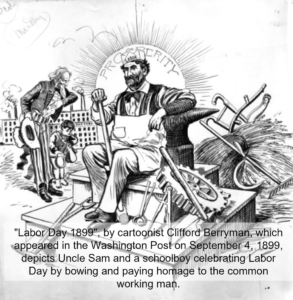Few people look forward to end of the summer. That may be the reason that the first Monday in September was set aside as a national holiday to celebrate Labor Day. It provides one last opportunity to gather and celebrate as families and friends. According to the U.S. Department of Labor, “Labor Day is a creation of the labor movement and is dedicated to the social and economic achievements of American workers. It constitutes a yearly national tribute to the contributions workers have made to the strength, prosperity, and well-being of our country.” The origin of the holiday can be traced back to celebrations that began well over a century ago. The Labor Department site reports:
“Through the years the nation gave increasing emphasis to Labor Day. The first governmental recognition came through municipal ordinances passed during 1885 and 1886. From these, a movement developed to secure state legislation. The first state bill was introduced into the New York legislature, but the first to become law was passed by Oregon on February 21, 1887. During the year four more states — Colorado, Massachusetts, New Jersey, and New York — created the Labor Day holiday by legislative enactment. By the end of the decade Connecticut, Nebraska, and Pennsylvania had followed suit. By 1894, 23 other states had adopted the holiday in honor of workers, and on June 28 of that year, Congress passed an act making the first Monday in September of each year a legal holiday in the District of Columbia and the territories.”
Workers are no less important for America’s future than they were 120 years ago. Nevertheless, the character of the workforce has changes significantly since the holiday was first celebrated. For one thing, the labor movement itself has weakened over the years. Michael Hiltzik (@hiltzikm) argues that the decline of unions began with passage of the Taft-Hartley Act of 1947. “Taft-Hartley,” he writes, “placed draconian restrictions on union activities, including picketing and strikes, and gave the green light to state right-to-work laws that barred union shops.” [“What really caused the decline of American unions?” Los Angeles Times, 5 March 2014] Others have pointed to bloated union overhead costs and corrupt leadership as contributing causes.
Drew DeSilver (@DrewDeSilver) reports that public perceptions of unions are mixed. “In a Pew Research Center survey conducted in June 2013,” he reports, “about half (51%) of Americans said they had favorable opinions of labor unions, versus 42% who said they had unfavorable opinions about them.” [“American unions membership declines as public support fluctuates,” Pew Research Center, 20 February 2014] He continues:
“That was the highest favorability rating since 2007, though still below the 63% who said they were favorably disposed toward unions in 2001. In a separate 2012 survey, 64% of Americans agreed that unions were necessary to protect working people (though 57% also agreed that unions had “too much power”). As of last year, however, only 11.3% of wage and salary workers belonged to unions, down from 20.1% in 1983, according to the Bureau of Labor Statistics. (At their peak in 1954, 34.8% of all U.S. wage and salary workers belonged to unions, according to the Congressional Research Service.)”
Whether you are supporter of labor unions or not, one fact is beyond dispute: America needs an educated and productive workforce in order to remain competitive. The Labor Department site declares, “The vital force of labor added materially to the highest standard of living and the greatest production the world has ever known and has brought us closer to the realization of our traditional ideals of economic and political democracy. It is appropriate, therefore, that the nation pay tribute on Labor Day to the creator of so much of the nation’s strength, freedom, and leadership — the American worker.” It’s fitting that American workers get a day to celebrate their contributions to making America great. From all us at Enterra Solutions®, we wish you a happy and safe Labor Day.




